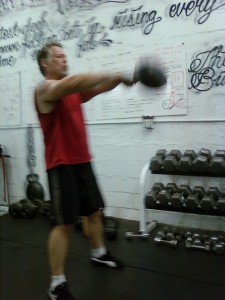These 4 strategies will get you seriously strong and conditioned if you work at them seriously! But first, a little back story.
Not so long ago, before graduating, I had to juggle between a job and school. As you may imagine, I had less than little time
workout. Before needing a job, I was able to put hours on the gym (I wasn’t always so focused, so a lot of time-wasting happened), and that was ok, I didn’t really need to worry about optimizing my workouts time-wise.
But, then real responsibilities came along and, quite frankly, I didn’t really have (nor want) the time to go for well over an hour in
the gym. There was a lot to do, namely enjoying the benefits of said work. This has been so for over 5 years now, and I wouldn’t go back to marathonic workout sessions. What did I do? Here’s a couple of strategies to do the same (or more) in less time.
1. Get more bang for you buck: Prioritize

Kettlebell work is almost made for circuit training. Photo by Lorant Dankahazi
This is as simple as it gets and implies cutting off extra work, and it works great for the development of strength. There’s several ways to go about it
- An exercise a day, plus some accessory work. Choose a big compound exercise such as the bench press, military press, squats or deadlifts and focus on it. Your accessory work should focus on something that builds towards it.
- Focus only on two big compound exercises and work exclusively on them. This is my favorite of both approaches. Pavel’s Power to the People protocol works amazing for this, and in 20 minutes a day (or a total of 1:40 hours a week) tops you’ll be getting a lot stronger.
2. Try circuit training
Working circuits is simple. You just grab a bunch of exercises and perform them one after the other. Your rest between exercises and circuits should reflect your. The magic of this is that your rest periods will be shortened anyway, since you’ll be somewhat recovering from one exercise while performing the rest.
Usually, when I do circuits they go something like this:
- A push
- A pull
- A knee bend (squat)
- A hip hinge (kettlebell ballistics or bridge)
- A core exercise
After every circuit I give myself two minutes of rest (or one, If I’m realllly feeling it) and start over. After 5 circuits I’m usually done for the day. Doing this 3-4 times a week will guarantee your success.
Reps and rest will depend on your conditioning level and your focus. If you’re going for a strength based practice you’ll do best with low reps and higher rests, invert it for conditioning. Or check out my post on defining your workout where I get better into it.
3. Density Training: Set a time and go!
This is by far my favorite of the 3 (Crossfitters may now it as AMRAP). Density in training is calculated as volume/time. Why is this a great type of training when you’re on a tight schedule? Because the progress in it is either in doing more in the same amount of time, or doing the same faster.
What has worked best for me Is to use a stop watch between 15-40 minutes and get my favorite circuit and go for it. Make sure to take note of your workout: how much did you do this practice? Great, now try to beat it by at least one rep or exercise completed on your next practice (always remember to practice safely though, the numbers will come).
Once you’ve added two rounds, change to harder exercises (usually best to change one at a time).
4. Extreme conditioning on the minute

Expect a healthy sweat! Photo by John Calnan
This is my favourite for finishers, but it’s a great conditioning tactic if you don’t have time. You’ll need a stopwatch or a timer. The idea is for you to do a set, rest for what’s left of the minute, and start over on the new minute. Kettlebell swings/snatches, burpees and bw squats work great here.
Wrap up
Any of these strategies will work wonders once you apply them, and will let you enjoy the rest of your life as well. They have been proven not only by me but by (at least) thousands who’ve used them successfully for their fitness goals. Just remember to fit them into your goals and you’ll be golden!
So, now that time’s no longer an excuse, what will you say when you won’t do it?
Also, If you’ve got any friends or family that complains for their lack of time, share this post with them, it may help them a lot!
Motus Virtute


